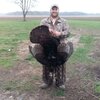Captcurt
Member
Been watching the birds lately. They have been gobbling big time for the last 3 weeks. Yesterday I watched 20 birds with 2 longbeards. The gobblers were strutting their butts off and it is almost 3 weeks until season. It seems that the AGFC believes that the reason for low harvest numbers is because of low population numbers so they open the season later. The fact is that the majority of the birds have been bred and breeding is over before season opens. I've watched this for several years now. If breeding is over here in northern Arkansas before season just imagine when it was over farther south. Come on you educated Biologist. Open your eyes.





